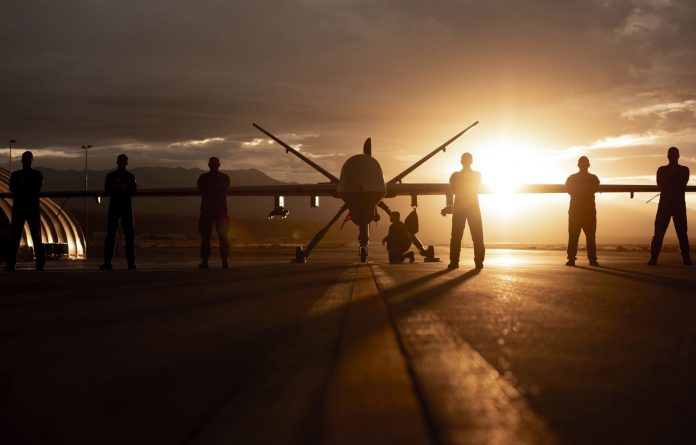
CREECH AIR FORCE BASE: In early 2009, a recently reactivated combat unit, now named the 432nd Wing/432nd Air Expeditionary Wing, achieved the mark of 500,000 hours of combat, for a relatively new form of airpower, known as remotely piloted aircraft.
In roughly a decade, the MQ-1 Predator and MQ-9 Reaper, RPAs designed for enhanced loitering capability and capable of precision strikes, and the Airmen who operate, maintain, and support it, have achieved milestones unheard of by traditionally-manned counterparts.
Born out of combat necessity, the MQ-1 and MQ-9 platforms were being operated through traditionally-trained manned aircraft pilots. The Air Force announced the creation of the 18X, remotely piloted aircraft pilot, career field training pipeline in June 2010.
By July 2011, one of the first Beta 18X graduates was also launch-and-recovery qualified, marking the beginning of a new era of pilot.
The same Airmen who laid the groundwork for training, also enhanced mission capabilities through the creation of the first intelligence, surveillance and reconnaissance video editing training program in 2012, which then secured the 432nd Wing/432nd Air Expeditionary Wing the 2013 Air Combat Command Meritorious Unit Award for outstanding achievement in direct support of combat operations.
The MQ-9, and its operators, proceeded to prove to combatant commanders its utility as a platform on par with traditional counterparts during a 2014 exercise, marking one of the first times RPA assets were allowed to travel in formation.
Soon after, the RPA enterprise community banded together to meet the secretary of defense initiative to support 65 combat lines, a stark contrast to the 33 combat lines flown in 2008.
Beginning in late 2014, the RPA Enterprise became pivotal in the eradication of the Islamic State group through Operation Inherent Resolve.
While the MQ-1 and MQ-9 mission in Iraq and Syria initially focused on information gathering and battlespace awareness, the 432nd Wing’s involvement quickly evolved, providing a persistent attack capability due to the precision effects provided by the MQ-1 and MQ-9 aircraft. Escalating in parallel with their own strikes from the MQ-1/9, the 432nd Wing has also provided a significant number of buddy lases, or a situation in which a laser-guided aircraft provides the final guidance from another aircraft, proving the platforms’ ability to integrate with traditional aircraft, such as the A-10 Warthog, F-15E Strike Eagle and F-16 Viper.
“Before OIR, many people may not have known what an RPA was truly capable of,” said Capt. Ryan, 15th Reconnaissance Squadron MQ-1 Predator. “Now before combatant commanders take the risk of potentially losing a manned aircraft they will come to us and ask if we’ve found them targets. We have 24/7 coverage, so we know what the battlefield looks like and how it has changed. They’re using us for their situational awareness which improves their safety as well.”
The milestones and innovations within the 432nd Wing/432nd AEW were vast within, but not limited to, the battlespace. Airmen within the unit challenged technology, tactics, techniques and procedures through regulated integrations with exercise creations such as the communications device, “Frankenphone,” as well as testing and implementation of new munitions such as the GBU-38 in 2017.
Arguably one of the largest changes for the enterprise was the retirement of the MQ-1 Predator from the Air Force inventory in March 2018. This marked the beginning of an all-MQ-9 Reaper force.
Closing out the decade, 2019 was not short of record-making.
The month of March marked the combined milestone of the MQ-1 and MQ-9 reaching 4 million flight hours. Soon following, Creech Air Force Base gained dedicated support functions through the activation of its own Mission Support Group.
The stand-up of the MSG enabled the 432nd Wing/432nd AEW commander, Col. Stephen Jones, to gain installation command authority of Creech AFB, which previously served as an auxiliary of Nellis AFB.
The growth and development of infrastructure for Creech AFB ties directly to the demand of the MQ-9 and the Airmen who enable its mission. The longevity of the Reaper, and the pursuit of greater utilization of its capabilities, is evident when looking forward to 2020.
“Where I’m focused as we enter the new year is to continue strong with our current mission,” Jones said. “Our next step is to prepare our (MQ-9) weapons system for potential future conflicts. You will see us evolve, not only our hardware and software, but the tactics, techniques and procedures that we use to more effectively employ our Reapers in anticipated contested environments.
“This is a mission that is non-stop, it has been for years, and it will continue for years.”
from Defense News by DefenceTalk.com https://ift.tt/2N46M79
via Defense News
No comments: